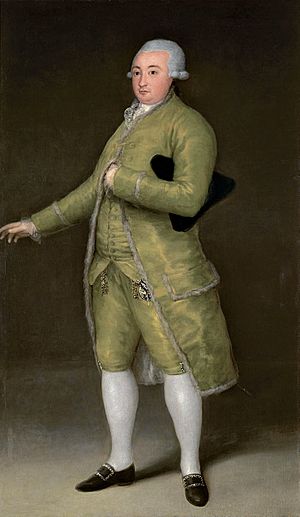François Cabarrus facts for kids
Quick facts for kids
The Count of Cabarrús
|
|
|---|---|
 |
|
| Minister of Finances | |
| In office 7 July 1808 – 27 April 1810 |
|
| Monarch | Joseph I |
| Preceded by | Miguel José Azanza |
| Succeeded by | José Martínez de Hervás |
| Personal details | |
| Born | 1752 Bayonne |
| Died | 1810 Seville |
| Resting place | Seville Cathedral |
François Cabarrus (also known as Francisco Cabarrús Lalanne), who was given the title of Count de Cabarrús, was a French adventurer and a Spanish financier. He was born in 1752 and passed away in 1810.
Contents
Life of Francisco Cabarrús
Early Years and Family
Francisco Cabarrús was born in Bayonne, France. His father, Dominique Cabarrus Fourcade, was a merchant and shipbuilder. His family had a long history of Basque sea-captains, whalers, and adventurers. They originally came from the Navarre region of Spain and settled in Capbreton, a town near Bayonne.
Young Francois was sent to study in Toulouse. However, his family called him back to Bayonne due to some personal issues. His father then sent him to Spain to work with a business partner named Galabert. There, he not only learned about business but also fell in love. He married Maria Antonia Galabert Casanova, his employer's daughter.
They made their home in Carabanchel Alto, a town close to Madrid. Maria Antonia's grandfather owned a soap factory there. Their large house in Carabanchel was called Maison St. Pierre. Years later, this house and its surrounding land became part of the estate of the Count of Montijo. Soon, Francisco Cabarrús became very interested in the public affairs of the court in nearby Madrid.
Reforms and Challenges
During this time, the ideas of the Age of Enlightenment were spreading in Madrid. King Charles III was open to new ideas and reforms. He was supported by a group of politicians, including Gaspar Melchor de Jovellanos and Count Campomanes. Cabarrús became very important among these reformers, especially in matters of finance.
He helped create the Banco de San Carlos, which was the first version of today's Bank of Spain. He also started a company called the Real Compañía de Filipinas to trade with South American colonies and Asia through the Philippine Islands.
Cabarrús also worked on a big farming and water project called the Canal de Cabarrus. This project was the beginning of today's Canal de Isabel II, which supplies water to Madrid. This canal is located northeast of the Madrid Community, near the Jarama river. He was also involved in other projects to build navigable waterways, but these were never finished.
When King Charles III died in 1788, his son Charles IV took over. Charles IV's government stopped many of the Enlightenment reforms. People who had supported these reforms, like Cabarrús, were viewed with suspicion. Cabarrús himself was accused of financial misconduct and put in prison in the Castle of Batres, a town near Madrid.
Under French Rule
After two years, Cabarrús was set free. He was given the title of count and worked on important state missions. He was even considered to be the Spanish ambassador to Paris. However, the French government did not agree because he was born in France.
Cabarrús did not play a part in the events that led King Charles IV to step down. This made way for Joseph Bonaparte, who was the brother of Napoleon Bonaparte, to become King Jose I of Spain. Because Cabarrús was French-born and knew a lot about Spain, Napoleon chose him for the difficult job of minister of finance. Cabarrús held this position until his death.
He passed away in Seville while traveling with Joseph Bonaparte. He is buried in the Cathedral of Seville.
Lasting Impact

Because Francisco Cabarrús supported Joseph Bonaparte during his time as king, he was seen as an afrancesado. This term was used for Spanish people who supported the French. Even though Cabarrús had already died, his family was treated badly when Ferdinand VII became king again. Their wealth and property were taken away. Over time, his family's inheritance was given back and then taken away again several times, depending on who was in power in Madrid.
His son and heir, Domingo Cabarrús Galabert, became the second Count of Cabarrús. He held several government jobs, including governor of the provinces of Palencia and Valladolid.
His daughter, Teresa Cabarrus Galabert, also known as Thérèse Tallien, also Madamme Tallien, played a role in the later stages of the French Revolution. People at the time called her "Notre Dame de Buon Secours" and "Notre Dame de Thermidor."
One of his grandsons, Domingo Cabarrus Quilty, married Enriqueta Kirkpatrick y Grivegnée. Enriqueta's sister, Manuela Kirkpatrick y Grivegnée, was the mother of Empress Eugenia de Montijo. Empress Eugenia married Emperor Napoleon III of France. Domingo Cabarrus Quilty died before his father, so he did not become the third Count of Cabarrús. His daughter, Paulina Cabarrus Kirkpatrick, inherited the title instead, becoming the third Countess of Cabarrús.
Francisco Cabarrús Lalanne also gained the title of Viscount of Rabouilhet. He originally intended this title for his other son, Francisco Cabarrus Galabert. However, this son died young. So, Francisco Cabarrús combined both titles. To this day, the Counts of Cabarrús also hold the title of Viscounts of Rabouilhet. The town of Rabouilhet and its surrounding areas are in the Lanquedoc region of France.
His close friend, the famous artist Francisco Goya, painted a full-body portrait of him. This painting is now displayed in the Bank of Spain building in Madrid.
See also
 In Spanish: Francisco Cabarrús para niños
In Spanish: Francisco Cabarrús para niños

